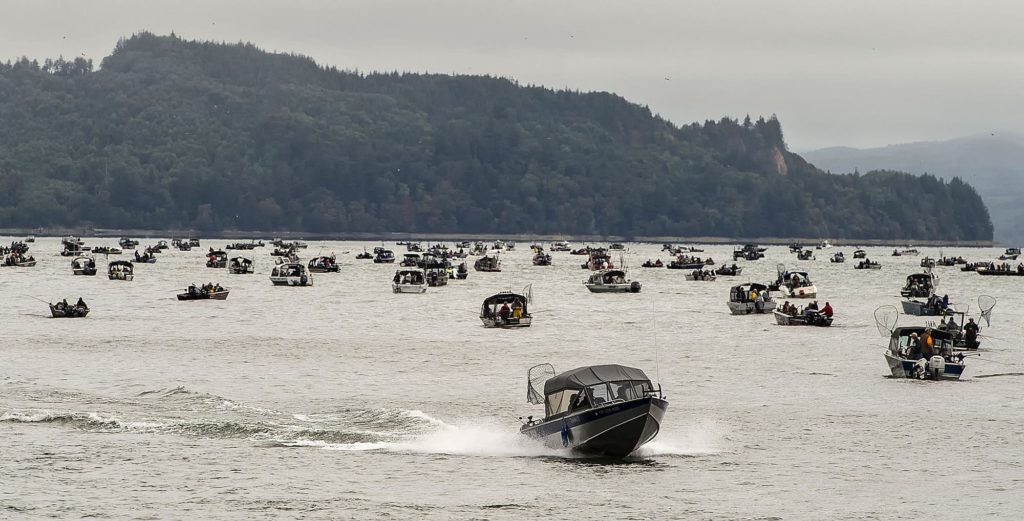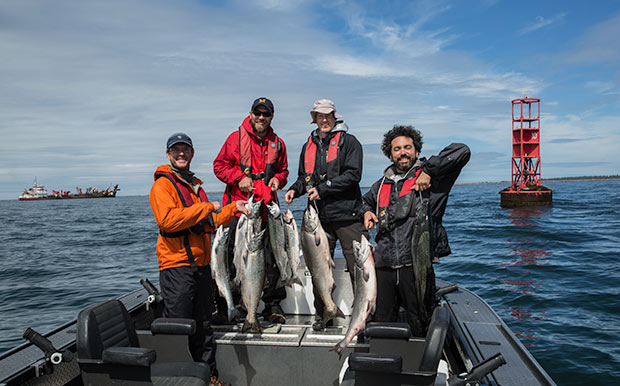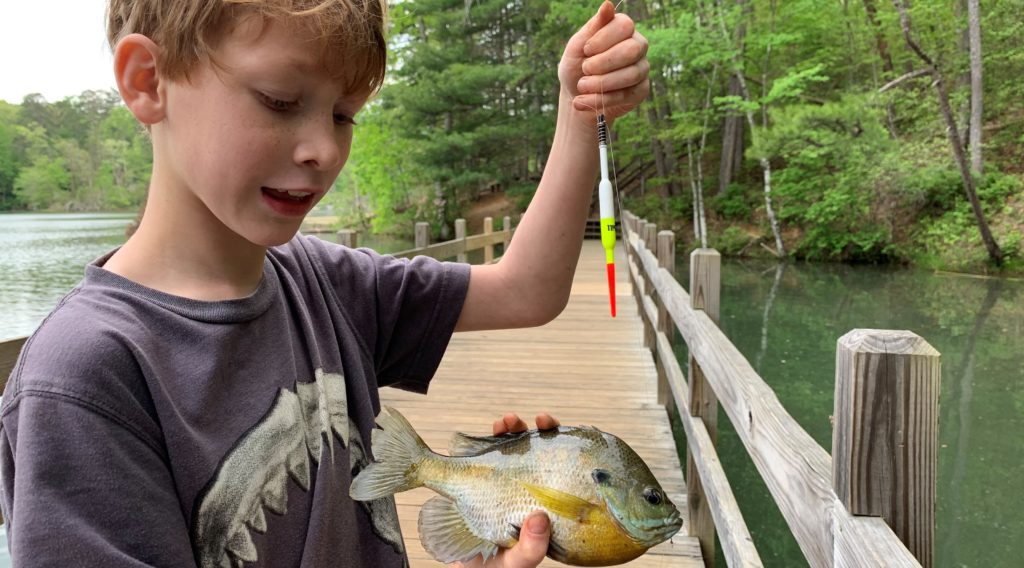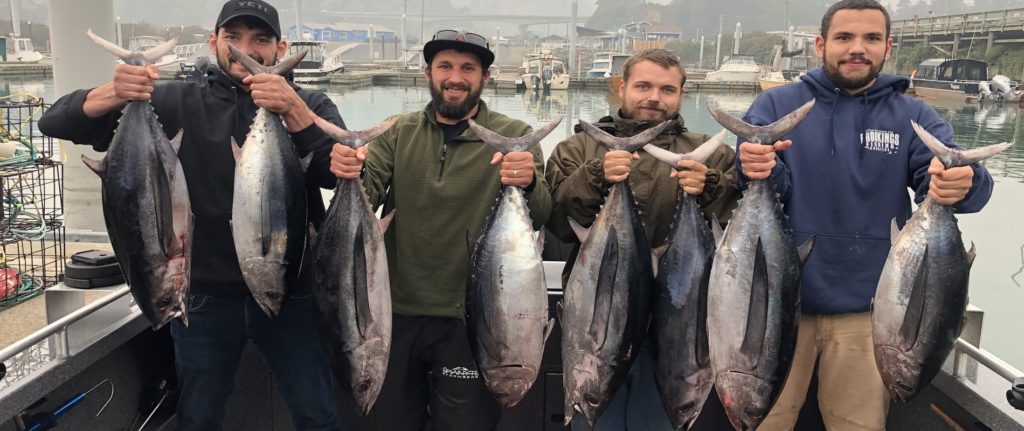No doubt about it, salmon, Chinook salmon, are the headliners for August. They’re being caught across the Northwest but the stronghold is the Buoy 10 fishery out of Astoria, Warrenton, Hammond, Chinook and Illwaco in the lower 15 miles of the river. These ports will host thousands of boats and tens of thousands of anglers over a couple of months.
There’s some concern (there usually is) that this year may be over-forecast for these fish but it’s unlikely. I’ll be happy to eat crow on this but truth be told, most years the fish managers get it right. So expect good fishing for kings.
The great fishing is on the way. And that will come in the form of silvers aka coho salmon. About 1.5 million are forecast to hit the Columbia. It should be red hot fishing later in August and through September and into October.
Here’s some Buoy 10 advice honed over 40 seasons of fishing the area.
If you want to beat the crowds at the launch, try Illwaco. It used to be busy but most years, even at peak fishing it’s not. You generally won’t have to wait long with your boat. That will not be the case at the East Mooring Basin (Astoria), Warrenton or Hammond. Those lines can go forever and it can be an awful experience at the launch with docks plugged and boats bobbing everywhere in the harbor. That’s generally not the case at Illwaco.
I didn’t mention Chinook. That’s a tricky launch and trip out to the river. It’s generally OK for missing the crowds but getting out of there and into the Columbia is a bit involved with a narrow, long channel in and out. The channel in and out of Illwaco is a bit long too but it’s wider and well-marked.

Another piece of advice, if you do launch in Illwaco be sure to wait until the tide bottoms out or just starts to flood back in. It can be pretty treacherous in that area trying to get into the Columbia on a hard-running outgoing tide.
It should go without saying but it’s worth mentioning anyway. Please, wear your PFD’s (personal floatation device) anytime you’re boating in the Columbia, or anywhere for that matter…but especially in the Columbia or any of the coastal fisheries. Things happen, and when they do, they happen fast…be prepared.
Next, know the tides you’ll be fishing. Is it a big tide? That is, a big exchange between high and low tide? Is it a soft tide…which is exactly the opposite condition? Big tides will bring the fish but the soft tides make for easier, safer boating conditions.
If you’re fishing a big tide, fish the flood (incoming) and that hour of high slack then beat it. It’s generally not worth fishing a heavy outgoing tide and it can get very rough and dangerous. It’s best to call it a day. Also, if you have a stiff west wind on an outgoing tide it can be downright deadly. Conversely, an east wind can lay the river down on an outgoing tide.
Finding frozen green label herring may be an issue this year. You’ll likely be able to find appropriately-sized fresh herring. Either way, and especially if you have to drop down a size or two (red or orange label), fish them whole. I’ve long preferred the profile of whole herring over cut plug, unless it’s the big blues or purple label herring.
This is a fishery that generally opens with a whimper and builds to a crescendo. This year should be no different. Expect slow fishing to start the month and it will intensify through the month.
Read the regulations. Don’t (please) rely on Facebook posts and hearsay, do the reading so you know, yourself, what the rules of engagement are. For example, barbless hooks only. Treble or single hook, it doesn’t matter…barbless. These fisheries are heavily regulated so that we can have seasons. Without the proper buffers in place these fisheries would be shut down.

When it comes to fishing, see what they want. Depending on how warm or cool the water is will dictate what your best fishing option is. For example, on a strong incoming tide out by Buoy 10 you’ll see a very good push of ocean water coming into the estuary. That water is generally cooler and is better-suited to bait, herring in particular. Further upriver, the temperature may be 10 degrees higher, and there, spinners and flashers are a better choice.
These fish don’t always follow the playbook. If they’re not biting spinners in the warmer water try herring or anchovies, at times it’s what they want.
The Buoy 10 fishery can be as easy as it gets at times and everyone feels like heroes and then it can change in an instant. The key is stay after it, try different things, make sure everything’s working and there are no weeds on your bait or lure.
Know the river. There are navigation hazards, some areas fish better than others, tides play a huge role in where to fish and stay out of the main channel unless you’re running from point-to-point.
It’s important to know where Clatsop Spit is (navigation hazard) and Desdemona Sands (another navigation hazard) are. If you don’t have a GPS (these days every boater should) then you should have a compass and know how to use it. Throughout the Buoy 10 season and through each day, fog can set in. Your GPS can keep you clear of the navigation hazards as well as the main channel. Your compass and depth finder will do the same but you need to know where you are in the river and which direction to go. North is generally a good direction to head if you need to get out of the main channel. When you get into 25’ of water you should be fine. If you ever hear five blasts of a ship’s horn it means you or someone else is in their way. Ships have the right of way.
The Buoy 10 fishery, that stretch of water from Cape Disappointment (Buoy 10’s a little west of it) up to Tongue Point, is not for beginners. If you’re new to it, select a soft tide, 2 foot exchange, and go out with someone who knows the area. You’ll be faced with a huge expanse of water.
Where the bridge crosses the river in Astoria it’s 4 miles across the river to the 10th of a mile and it’s roughly 15 miles from Illwaco to Tongue Point. For those that have spent their life fishing the area they’ll all be able to share horror stories. Its moniker, “Graveyard of the Pacific” is well-deserved. You also learn over time to parse the river up into smaller areas. It’s still a big river just not as big for those that sectioned it off.

The Buoy 10 fishery, that stretch of water from Cape Disappointment (Buoy 10’s a little west of it) up to Tongue Point, is not for beginners. If you’re new to it, select a soft tide, 2 foot exchange, and go out with someone who knows the area. You’ll be faced with a huge expanse of water.
Where the bridge crosses the river in Astoria it’s 4 miles across the river to the 10th of a mile and it’s roughly 15 miles from Illwaco to Tongue Point. For those that have spent their life fishing the area they’ll all be able to share horror stories. Its moniker, “Graveyard of the Pacific” is well-deserved. You also learn over time to parse the river up into smaller areas. It’s still a big river just not as big for those that sectioned it off.
A point to emphasize here is knowing when to get off the river. It’s probably the single-biggest mistake new boaters to the area make and it can be a mistake that costs you your life. If the west wind starts blowing against an outgoing tide…leave. The likelihood of it subsiding is low and it’s not worth waiting and finding out. Get back to port and wait it out or call it a day.
Of course, the best way to enjoy the Buoy 10 fishery if you’re new to it is to hire a guide or charter and start learning the area and how to fish it.
Buoy 10 isn’t the only salmon fishery in the region. Puget Sound is producing some nice chinook right now and will continue to kick out a mix of chinook and silvers over the entire month depending on where you’re fishing.

Again, check the regulations. In Washington, the salmon fishery along the coast and into Puget Sound is segmented into “Marine Areas” and regulated accordingly. You’ll want to be fluent on the regulations before wetting a line in any of these Marine Areas.
While all this frenzied activity is going on for salmon…trout, walleye, bass and panfish are all available and fishing can be quite good throughout the entire month of August. Expect low fishing pressure and good fishing. The high lakes in the Cascades and other places to the east can deliver exceptional fishing opportunity with little or no pressure. Looking for solitude? The high country is the place to be.
Hunters should be well into their scouting in August. The more time you put in the better your chances when the season opens.
Everyone venturing into the backcountry is advised to exercise extreme caution regarding any fires. Camp stoves only and where permitted. No campfires. Check with either County Parks or the National Forest on what’s allowed before setting out.
And of course, for those that like wide open spaces and wide open bites there’s tuna! This fishery peaks throughout the month and for some it’s the only place they like to go — in search of 63° blue water.
Whichever direction(s) you choose, please, do it safely and have fun! We want to see you at next year’s shows.
Oh and by the way, that spring Chinook fishery in the lower-Willamette we ballyhooed and promoted for months paid off! Fishing was good-to-very-good most trips. We fished three hours or so in the morning and then went into the office. Just fished 3.5 spinners and flashers — easy. And we had a ball. Can’t wait until next year. I think we’ll start a little earlier, probably the last week of May. We’ll keep you posted.